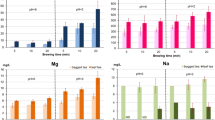Abstract
Tea infusions provide many valuable nutrients, including elements. Lithium (Li) is an element which appears rather in small amounts both in environment and in the human tissues or body fluids. Now it is known that it plays a part in many important vital functions. Content of Li in food products is generally small, which is associated with its low consumption. The aim of the study was to examine the concentration of Li in the infusions prepared from different sort of teas available in the market. The content of Li was examined in 55 infusions of black, green, red, fruit and herbal teas. Quantitative studies were performed using atomic absorption spectrometry with atomization in graphite furnace. The largest amount of Li was extracted from the leaves of red tea and rooibos as well as some herbal teas. The determined content of Li in tea infusions was in the range 0.02–1.36 µg/g of tea, and 1 cup (250 mL) of analysed infusions (together with a tap water) provides 2.2–3.0 µg of Li.

Similar content being viewed by others
References
Aral H, Vecchio-Sadus A (2008) Toxicity of lithium to humans and the environment—a literature review. Ecotoxicol Environ Saf 70:349–356
Dafflon M, Decosterd LA, Biollaz J, Preisig M, Dufour H, Buclin T (1999) Trace lithium in mood disorders. J Affect Disord 54:199–203
Goullé JP, Mahieu L, Castermant J, Neveu N, Bonneau L, Lainé G, Bouige D, Locroix Ch (2005) Metal and metalloid multi-elementary ICP-MS validation in whole blood, plasma, urine and hair. Forensic Sci Int 153:39–44
Iyengar GV (1998) Reevaluation of the trace element content in reference man. Radiat Phys Chem 51:545–560
Leflon P, Plaquet R, Rose F, Hennon G, Ledeme N (1996) Rapid determination of lithium serum and urine, at physiological concentrations, by inductively coupled argon plasma atomic emission spectrometry. Anal Chim Acta 327:301–306
Schrauzer GN (2002) Lithium; occurrence, dietary intakes, nutritional essentiality. J Am Coll Nutr 21:14–21
Usuda K, Kono K, Dote T, Watanabe M, Shimizu H, Tanimoto Y, Yamadori E (2007) An overwiew of boron, lithium, and strontium in human health and profiles of these elements in urine in Japanese. Environ Health Prev Med 12:231–237
Norra C, Feeilhauer J, Wiesmüller GA, Kunert HJ (2010) Differential effects of endogenous lithium on neurobehavioural functioning: a study on auditory evoked potentials. Psych Res 178:176–181
Schöpfer J, Schrauzer GN (2011) Lithium and other elements in scalp hair of residents of Tokyo prefecture as investigational predictors of suicide risk. Biol Trace Elem Res 144:418–425
Léonard A, Hantson Ph, Gerber GB (1995) Mutagenicity, carciongenicity and teratogenicity of lithium compounds. Mutat Res 339:131–137
Young W (2009) Review of lithium effects on brain and blood. Cell Transpl 18:951–975
Schrauzer GN, Shrestha KP, Flores-Arce MF (1992) Lithium in scalp hair of adults, students, and violent criminals. Biol Trace Elem Res 34:161–176
Rubio Armendáriz C, Gonzalez-Weller D, Gutierrez Fernandez AJ, Haridsson De la Torre A (2010) Levels of lithium in the six most taken groups of food among the canarian population. Abstracts/Toxicol Lett P307-004:298
Tamari Y, Tsuchiva K (2004) Determination of lithium in food by flame photometry. Bunseki Kagaku 53(1):41–44
Almeida CM, Vasconcelos MT, Barbaste M, Medina B (2002) ICP-MS multi-element analysis of wine samples—a comparative study of the methodologies used in two laboratories. Anal Bioanal Chem 374:314–322
Długaszek M, Połeć J (2012) Content of lithium in mineral and spring waters. Bromat Chem Toksykol XLV(2):138–143
Evans WH, Read JI (1985) Determination of lithium, rubidium and strontium in foodstuffs. Analyst 110:619–623
Evans WH, Read JI, Caughlin D (1985) Quantification of results for estimating elemental dietary intakes of lithium, rubidium, strontium, molybdenium, vanadium and silver. Analyst 110:873–877
Van Cauwenbergh R, Hendrix P, Robberecht H, Deelstra H (1999) Daily dietary lithium intake in Belgium using duplicate portion sampling. Lebensm Unters Forsh A 208:153–155
Długaszek M, Kłos A, Bertrandt J (2012) The supply of lithium in the daily food rations of students of the main school of fire service. Probl Hig Epidemiol 93(4):867–870
Pękal A, Biesaga M, Pyrzyńska K (2013) Trace metals and flavonoids in different types of tea. Food Sci Biotechnol 22(4):925–930
Perucka I (2001) Chemical composition of tea leaves. Biul Magnezol 6(3):443–451
Szymczycha-Madeja A, Welna M, Pohl P (2012) Elemental analysis of teas and their infusions by spectrometric methods. TrAC 35:165–181
Gajewska R, Nabrzyński M, Ganowiak Z, Cybulski M, Kułakowska D (2000) The contents of some minerals in the green and black teas. Ann Natl Inst Hyg 51(3):251–258
Łozak A, Sołtyk K, Ostapczuk P, Fijałek Z (2002) Determination of selected trace elements in herbs and their infusions. Sci Total Environ 289:33–40
Özcan MM, Ünver A, Uçar T, Arslan D (2008) Mineral content of some herbs and herbal teas by infusion and decoction. Food Chem 106:1120–1127
Ødegård KE, Lund W (1997) Multi-element speciation of tea infusion using cation-exchange separation and size-exclusion chromatography in combination with Inductively Coupled Plasma Mass Spectrometry. J Anal Atomic Spectrom 12:403–408
Marcos A, Fisher A, Rea G, Hill JS (1998) Preliminary study using trace element concentrations and a chemometrics approach to determine the geographical origin of tea. J Anal Atomic Spectrom 13:521–525
Acknowledgments
This study was supported by the Institute of Optoelectronics (project number PBS 903).
Conflict of interest
None.
Compliance with Ethics Requirements
This article does not contain any studies with human or animal subjects.
Author information
Authors and Affiliations
Corresponding author
Rights and permissions
About this article
Cite this article
Maria, D., Żaneta, K. & Jadwiga, M. Lithium content in the tea and herbal infusions. Eur Food Res Technol 241, 289–293 (2015). https://doi.org/10.1007/s00217-015-2456-4
Received:
Revised:
Accepted:
Published:
Issue Date:
DOI: https://doi.org/10.1007/s00217-015-2456-4




